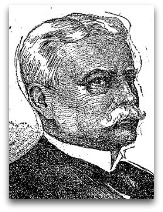
Perhaps I begin to sound like a broken phonograph, but I find that chapter 28—“Scientists Condemn Evolution”—of William A. Williams’s The Evolution of Man Scientifically Disproved (1925) is the gift that keeps on giving. (The phrase, I find, was originally a marketing slogan for a phonograph, so there you go.) That chapter is chockablock with a lot of quotations from various scientific authorities. As it happens, I’ve already blogged here at the Science League of America about a number of them: including Lionel S. Beale, Albert Fleischmann (misspelled “Fleishman” by Williams), St. George Mivart (misspelled “Mivert” by Williams), Ernst Haeckel, Nathaniel S. Shaler (although Williams didn’t misattribute his words to Darwin), Oscar Fraas (misspelled “Traas” by Williams), and, most recently, Thomas Henry Huxley. And now it’s the turn of W. H. Thompson.
According to Williams, “Dr. W. H. Thompson, former president of NY Academy of Medicine, said: ‘The Darwinian theory is now rejected by the majority of biologists, as absurdly inadequate. It is absurd to rank man among the animals. His so called fellow animals, the primates—gorilla, orang and chimpanzee—can do nothing truly human.’” Where did Williams find the passage? Although he acknowledges taking his “testimonies” from earlier books, namely, Luther Townsend’s Collapse of Evolution (1905), Alfred W. McCann’s God—Or Gorilla (1922), and Philip Mauro’s Evolution at the Bar (1922), none of these contains the passage from Thompson. The earliest instance of the quotation I was able to find was in the August–September 1922 issue of Theological Monthly (“published by the Evangelical Lutheran Synod of Missouri, Ohio, and other states”), which was itself quoting from the May 9, 1922, issue of the Lutheran Church Herald.
As quoted in Theological Monthly, the passage appears thus: “Dr. William Hanna Thompson, president of the New York Academy of Medicine, says: ‘The Darwinian theory is now rejected by the majority of biologists as absurdly inadequate, owing to its principle’s being wholly negative. Selection of any kind does not produce anything.’” The minor divergences—whether Thompson’s initials or first and middle names are used; whether he is described as the president or the former president of the New York Academy of Medicine—aren’t important as compared to the major divergence. On the showing of Theological Monthly, Thompson is expressing opposition to Darwinism sensu the effectiveness of natural selection, as (for instance) Harold Begbie and D’Arcy Wentworth Thompson did, while according to Williams, Thompson is expressing opposition to Darwinism sensu the common ancestry of humans and primates.
Which is it? Well, the horse’s mouth appears to be a column, “The Mystery of Life and the Mystery of Man,” published in The New York Times for November 5, 1911, under the byline of Dr. William Hanna Thomson (above)—note the absence of a p from the surname. In a box by the headline, there appears:
The Darwinian theory is now rejected by the majority of biologists as absurdly inadequate, owing to its principle being wholly negative. Selection of any kind does not produce anything, but only chooses between that which already exists.
Evolution never was a cause, but a result, instead.
It is almost pathetic to read how Huxley and Darwin, in their day, fancied that because the primate homo [sic]—man—was so well in keeping with the evolution of the other primates, therefore they had scientifically accounted for man.
It is absurd to rank man among the animals. His so-called fellow-animals, the primates—gorilla, orang, and chimpanzee—can do nothing truly human.
Mirabile dictu, both Theological Monthly and Williams are apparently right: Thomson is evidently expressing opposition both to the effectiveness of natural selection in evolution (as in the first paragraph) and to the common ancestry of humans and primates (as in the third and fourth paragraphs).
But the situation isn’t quite so simple. The material in the box is excerpted from the column—perhaps by the editorial staff of the Times—and is therefore taken, to a degree, out of context. In particular, in the context of his column, Thomson is not so much objecting to the common ancestry of humans and primates—he refers without demur to “the appearance of the anthropoid apes, such as the gorilla, orang, and the chimpanzee, who together constitutes the zoological genius of the primates, which, in turn, culminated in the animal homo [sic]. Homo, or man, is as much an animal as any other animal”—as he is objecting to the idea that biology is capable of explaining what’s distinctive about humans. “The more this epoch is studied,” Thomson declaims, “the more impossible it is to account for the advent of the person [as opposed to the animal], man.” And what is it about humans that biology is incapable of explaining?
As it happens, Thomson thinks that humans are distinctive in possessing intellectual, creative, invisible, indivisible, and eternal personalities, unlike “the brutes that perish.” (The column is duly ornamented by a reproduction of Italo Sabatini’s “There Is No Death,” described as “a striking painting … showing the passing of the soul [apparently not invisible after all] from the body.” The Times reproduced the painting earlier in 1911, under the headline “Art and Spiritualism,” and then thriftily used it also to accompany Oliver Lodge’s 1913 article headlined “President of the British Association Also Believes that Discarnate Intelligence Under Certain Conditions May Interact with Us on the Material Side.”) Whatever there is to be said for or against the view, Thomson seems to regard it as consistent with human evolution, making Williams’s use of the passage illicit—which, by now, is hardly a surprise.

